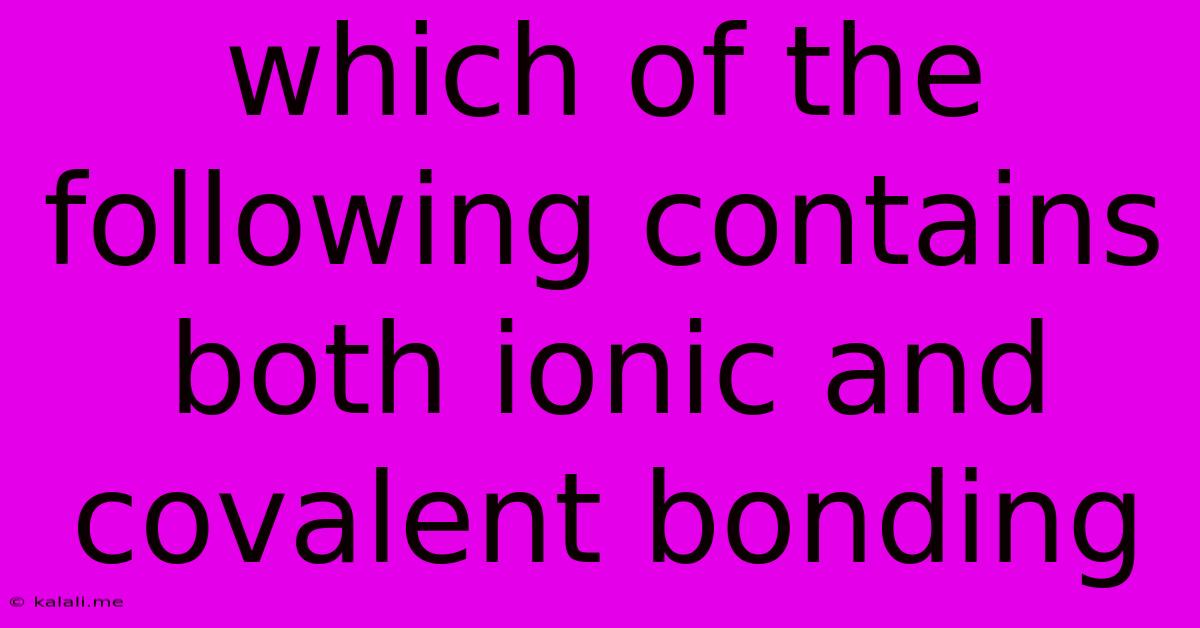Which Of The Following Contains Both Ionic And Covalent Bonding
Kalali
Jun 15, 2025 · 3 min read

Table of Contents
Which of the Following Contains Both Ionic and Covalent Bonding? Understanding Polyatomic Ions
This article will explore the fascinating world of chemical bonding, focusing specifically on compounds that exhibit both ionic and covalent bonding. We'll delve into the definitions of each bond type and then examine how they coexist within certain molecules. Understanding this dual bonding mechanism is crucial for comprehending the properties and behavior of many common substances.
What are Ionic and Covalent Bonds?
Before we dive into compounds containing both bond types, let's quickly review the fundamental differences:
-
Ionic Bonds: These bonds form through the electrostatic attraction between oppositely charged ions. This typically happens when a metal atom loses one or more electrons (becoming a positively charged cation) and a nonmetal atom gains those electrons (becoming a negatively charged anion). Think of it as a transfer of electrons. Examples include NaCl (sodium chloride) and MgO (magnesium oxide).
-
Covalent Bonds: In contrast, covalent bonds involve the sharing of electrons between two nonmetal atoms. Neither atom completely loses or gains electrons; instead, they share electrons to achieve a stable electron configuration. Examples include H₂O (water) and CH₄ (methane).
Compounds with Both Ionic and Covalent Bonds: The Role of Polyatomic Ions
The key to understanding compounds possessing both ionic and covalent bonds lies in the concept of polyatomic ions. These are charged groups of atoms held together by covalent bonds, acting as a single unit in ionic compounds.
Think of it this way: the polyatomic ion itself is held together internally by covalent bonds. However, this entire charged group then forms an ionic bond with an ion of opposite charge.
Examples of Compounds Exhibiting Both Ionic and Covalent Bonding:
Let's examine some common examples to illustrate this concept:
-
Sodium hydroxide (NaOH): This compound consists of a sodium cation (Na⁺) and a hydroxide anion (OH⁻). The hydroxide ion (OH⁻) contains a covalent bond between the oxygen and hydrogen atoms. The sodium cation and the hydroxide anion are then held together by an ionic bond.
-
Ammonium chloride (NH₄Cl): Here, we have an ammonium cation (NH₄⁺) and a chloride anion (Cl⁻). The ammonium ion is a polyatomic ion with covalent bonds between the nitrogen and hydrogen atoms. The ammonium cation and the chloride anion interact through an ionic bond.
-
Potassium nitrate (KNO₃): This compound contains a potassium cation (K⁺) and a nitrate anion (NO₃⁻). The nitrate ion has covalent bonds between the nitrogen and oxygen atoms. The ionic bond exists between the potassium cation and the nitrate anion.
-
Sodium sulfate (Na₂SO₄): Sodium sulfate contains sodium cations (Na⁺) and sulfate anions (SO₄²⁻). The sulfate anion exhibits covalent bonding between sulfur and oxygen atoms, while ionic bonding is present between the sodium cations and the sulfate anions.
Identifying Compounds with Dual Bonding:
To identify if a compound contains both ionic and covalent bonds, look for the presence of polyatomic ions. If the chemical formula includes a group of atoms enclosed in parentheses with a charge (e.g., (OH)⁻, (NH₄)⁺, (SO₄)²⁻), it strongly indicates the presence of both ionic and covalent bonding.
In Conclusion:
Many common compounds exhibit a fascinating interplay of ionic and covalent bonding. Understanding polyatomic ions is crucial for grasping this dual nature of chemical bonding. By recognizing the presence of these charged groups of covalently bonded atoms, we can accurately identify and understand the structure and properties of these important substances.
Latest Posts
Latest Posts
-
Center Of Mass Of A Trapezoid
Jun 16, 2025
-
Did Rabindranath Tagore Refused Nobel Prize
Jun 16, 2025
-
The Difference Between Inference And Observation
Jun 16, 2025
-
Amine Vs Amide Vs Imine Vs Imide
Jun 16, 2025
-
Which Idea Was Supported By Both Plato And Aristotle
Jun 16, 2025
Related Post
Thank you for visiting our website which covers about Which Of The Following Contains Both Ionic And Covalent Bonding . We hope the information provided has been useful to you. Feel free to contact us if you have any questions or need further assistance. See you next time and don't miss to bookmark.